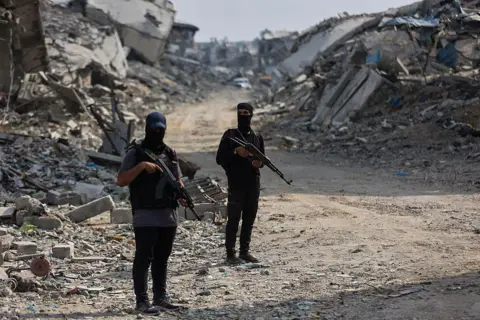Hugo BachagaMiddle East Correspondent in the East, Jerusalem
 Ahida
AhidaThe President of the United States of America Donald Trump and Jared Kusner, returned to Israel on Monday to face a new obstacle in the fragile negotiations in the next stop and more complicated phase.
The key sticking points remain unresolved, including the discovery of Hamas, the reconstruction and future governance of Gaza, and the deployment of an international security force in the territory.
Without a timeline for the talks, which will likely require significant concessions from Israel and Hamas, there are doubts that any progress will be achieved.
Another challenge emerged recently, involving many Hamas fighters believed to be in the tunnels under the Southern City of Ra-yellow line “, which marks the area under Israeli control.
 Israel GPO VIA EPA
Israel GPO VIA EPALast week, US special envoy Steve Witkoff said an amnesty could be offered for fighters who laid down their arms, and that this could be a “model” for what Washington hoped to apply in the rest of Gaza.
WitKOff said 200 fighters were detained, although this number has yet to be confirmed.
According to media reports, Kusner and the Prime Minister of Israel, Benjamin Netanyahu, discussed the issue in a meeting in Jerusalem on Monday.
Hamas has previously said the fighters would not surrender and demanded that they be granted safe passage, which Israel has so far rejected.
An Israeli government spokeswoman said Netanyahu and Kushner had “discussed phase one, which we are currently still in, to bring our remaining hostages, and the future of phase two of this plan, which includes the disarming of Hamas, demilitarizing Gaza, and ensuring Hamas will have no role in the future of Gaza ever again”.
The war in Gaza was triggered by the attack of Hamas in southern Israel on 7 October 2023, when about 1,200 people were killed and 251 others were taken hostage.
Since then, more than 69,000 people have been killed in Israeli attacks on Gaza, according to the Hamas-run Health Mismal Ministry, whose figures the UN relies on.
The first phase of the ceasefire, which was forced last month, focused on stopping the war, returning all the hostages, and admitting an influx of humanitarian aid to Gaza.
Twenty living hostages and the remains of 24 dead hostages were released, with four bodies remaining in Gaza.
In return, Israel released 250 Palestinian prisoners from its jails and 1,718 prisoners from Gaza without charge or trial. This was also given to the remaining 315 Palestinians from Gaza.
Israel and Hamas have accused each other of violating the truce, with Hamas saying that the return of the remaining hostages was intentional and Hamas saying that Israel killed at least 240 Palestinians and prevented the entry of aid supplies.
Hamas has previously rejected disarmament, saying it would only do so once a Palestinian state has been established. Israel denies any involvement in the administration of Gaza by the Western-launched Palestinian Authority, which is the body that governs parts of the Occupied West Bank. Countries are reluctant to commit troops to a multinational force without clear objectives, worried that their soldiers may face fighters from Hamas and other Palestinian factions.
The Israeli military currently occupies 53% of the territory of Gaza and is expected to withdraw further in the next phase of the plan.
With no sign of imminent developments in the negotiations, A de-facto partition of Gaza between an area controlled by Israel and another ruled by Hamas is increasingly likely, sources told news outlets.with talks about reconstruction likely to be limited to territory controlled by Israel.
Arab countries have already expressed concerns that the current disengagement could turn into a permanent disengagement from Gaza.
The Trump plan does not include a path to Palestinian status – a concept Israel rejects.


